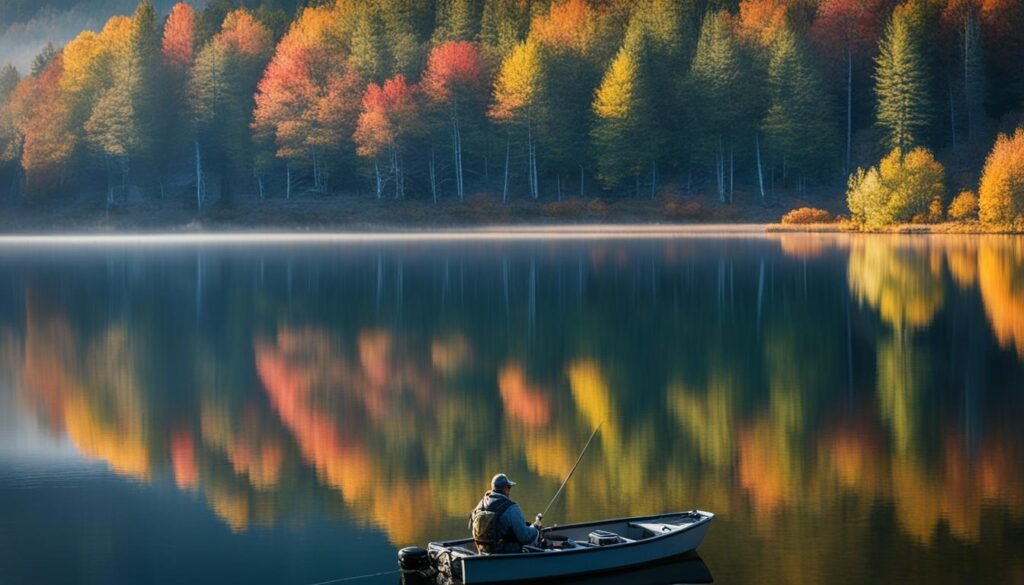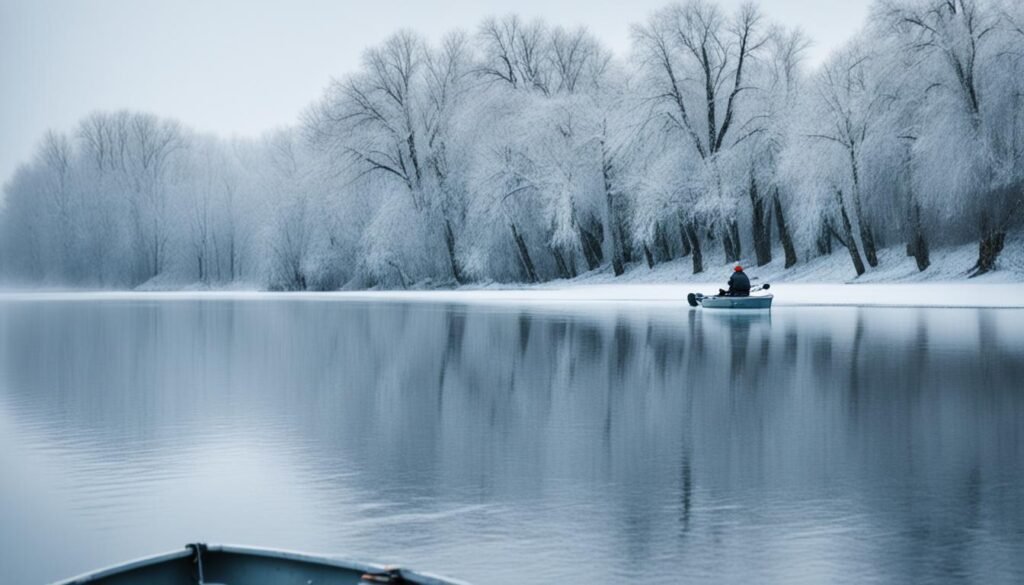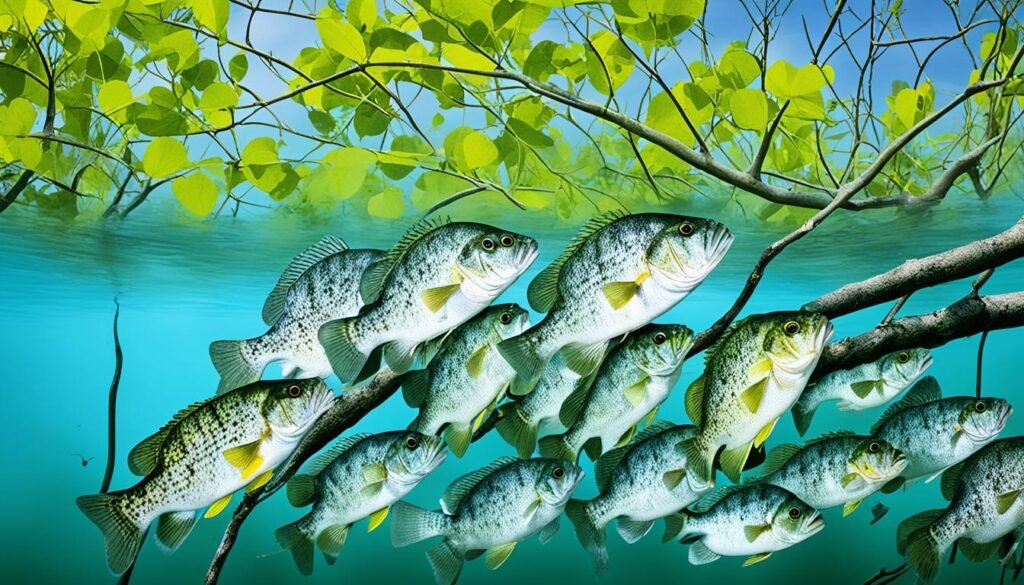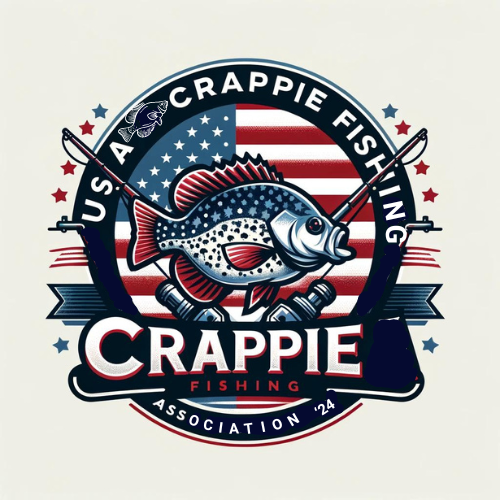“The two best times to fish is when it’s rainin’ and when it ain’t.”
When it comes to crappie fishing, timing is everything. Knowing the optimal seasons and hours to target these fish can greatly increase your chances of a successful fishing trip. Crappie, also known as speckled perch or papermouths, are renowned for their tasty meat and challenging nature. Whether you’re a seasoned angler or a beginner, understanding the patterns and behaviors of crappie is essential to reel in a big catch.
Key Takeaways:
- Understanding the optimal seasons and hours for crappie fishing can greatly increase your chances of success
- Spring and fall are generally the best seasons for crappie fishing, with crappie becoming more active and feeding aggressively
- Water temperature plays a crucial role in crappie behavior and fishing success
- Locating the right spots, such as creek and river channel ledges, can significantly improve your chances of catching crappie
- Adapting your fishing techniques and staying updated on local fishing reports can enhance your chances of a fruitful trip
Spring Fishing for Crappie
During the spring season, crappie fishing can be at its best. As the water temperature warms up, crappie become more active and feed more aggressively. It is recommended to fish in the late afternoon and early evening during this time. Early season crappie can be found in shallow water near woody debris and vegetation. Popular baits for spring crappie fishing include minnows and small jigs.
As the days get longer and the weather starts to warm up, crappie fishing enthusiasts eagerly anticipate the arrival of spring. This season brings a surge of energy and activity to crappie populations, making it an excellent time to hit the water and reel in some great catches. The increasing water temperature triggers a feeding frenzy among crappie, and they become more willing to bite.
When targeting crappie in the spring, it’s important to note that they are more active during the late afternoon and early evening hours. This is when their feeding behavior peaks, and they are more likely to be found in search of food. By planning your fishing trips accordingly, you can maximize your chances of success.
Early in the spring, crappie can be found in shallow water areas, particularly near woody debris and vegetation. These areas provide cover and serve as prime feeding grounds for hungry crappie. By focusing your efforts in these locations, you can increase your chances of encountering a school of crappie ready to strike at your bait.
When it comes to bait selection for spring crappie fishing, there are a few tried-and-true options that consistently produce great results. Minnows are highly effective and are often considered the go-to bait for crappie. Their lifelike movements and natural scent make them irresistible to hungry crappie. Additionally, small jigs in various colors can mimic the prey that crappie feed on, enticing them to strike.
Crappie Fishing Techniques for Spring
Spring crappie fishing requires some specific techniques to increase your chances of success. One effective technique is to use a slow retrieve, allowing the bait to mimic the natural movements of prey that crappie are actively seeking. This slow and deliberate approach can trigger more strikes and entice even the most reluctant crappie to bite.
Another technique that can yield great results is vertical jigging. This involves dropping your bait vertically into the water column, allowing it to sink to the desired depth. Once the bait reaches the target depth, use gentle jigging motions to create subtle movements that attract nearby crappie.
Pro Tip: “When spring crappie fishing, don’t be afraid to experiment with different bait colors and sizes. Crappie can have specific preferences depending on the day and water conditions.”
Remember to pay attention to your surroundings and adjust your approach accordingly. Keep an eye out for any signs of crappie activity, such as surface disturbances or clusters of baitfish. These indicators can lead you to productive fishing spots and increase your chances of landing a trophy-sized crappie.
Best Seasons for Bass Fishing
When it comes to bass fishing, spring is an excellent season to cast your line. Largemouth bass, in particular, thrive in slightly warmer waters compared to crappie. During the spring, before and after their spawning period, largemouth bass are more active and ready to bite.
For the best bass fishing experience, head out to the water early in the morning or during the late afternoon. These are the prime hours when bass tend to be most active and actively feeding. By aligning your fishing schedule with their feeding patterns, you’ll increase your chances of a successful catch.
As for lures, spinner baits, jig-and-pig baits, and plastic salamanders are popular choices that have proven to be effective in enticing largemouth bass. These lures mimic the natural prey of bass and can attract their attention. Experimenting with different lures and techniques is key to finding what works best for you.

Fishing Tips for Bass
- Focus on areas with vegetation, such as weed beds or lily pads, where bass like to hide and ambush their prey.
- Try different retrieval speeds and techniques, such as slow and steady, or quick and jerky, to entice strikes from curious bass.
- Pay attention to the water clarity and adjust your lure color accordingly. In murky water, go for brighter colors, while in clear water, opt for natural or more subdued tones.
- Don’t be afraid to experiment with topwater lures, especially during the early morning or late evening when bass may be more willing to strike at surface baits.
Remember, bass fishing success is not only about the equipment you use but also about understanding their behavior and adapting your strategies accordingly. Take note of the seasonal patterns and make the most of the opportune times to catch bass.
Summer Crappie Fishing Tips
During the summer months, crappie tend to seek deeper waters where it is cooler. However, there are still opportunities to catch them using the right techniques and targeting the right spots. Here are some summer crappie fishing tips to help you improve your chances of success.
Timing is Key
When it comes to summer crappie fishing, timing is crucial. The best times to fish for crappie during the summer are early morning, late afternoon, and nighttime. During these times, crappie are more active and more likely to bite. The cooler temperatures and reduced sunlight make them more willing to come out from the depths.
Shallower Areas
Although crappie generally prefer deeper waters in the summer, they may still frequent shallower areas during cooler periods. In the early morning or on cooler days, you may find crappie in shallower zones near vegetation or other forms of cover. These areas provide shade and slightly cooler temperatures, making them attractive to crappie.
Fishing Without a Boat
Not everyone has access to a boat for summer fishing. However, that doesn’t mean you can’t have success targeting crappie. One effective strategy is to fish from docks. Docks provide structure and shade, making them ideal spots for crappie to seek refuge from the summer heat. Drop your bait next to the dock posts or in any areas with submerged structure to entice crappie into biting.
Remember, crappie fishing in the summer requires a bit more strategy and patience. It’s important to adjust your techniques according to the weather and adapt to the behavior of the fish. By targeting the right spots and using effective techniques, you can increase your chances of a successful summer crappie fishing trip.
| Summer Crappie Fishing Tips | Description |
|---|---|
| Timing | Fish early morning, late afternoon, and at night for increased activity. |
| Shallower Areas | Explore shallower zones near vegetation and cover for crappie seeking cooler temperatures. |
| Fishing Without a Boat | Fish from docks to take advantage of structure and shade that attracts crappie. |
Fall Crappie Fishing Strategies
In the fall season, crappie fishing reaches its peak as these fish become more active and voracious in their feeding habits. As they prepare for winter, crappie can be found in abundance, making it an exciting time for anglers to get out on the water.
When targeting crappie in the fall, it’s essential to take advantage of the cooler parts of the day. The early morning and late evening, especially during sunrise and sunset, are prime times to hook into these hungry fish.
As the water temperature drops, crappie tend to move towards deeper areas. They typically follow their prey, which also migrates to deeper waters in search of cooler temperatures. Therefore, anglers should focus their efforts on fishing in deeper spots to increase their chances of success.
When it comes to fall crappie fishing techniques, several approaches can yield favorable results. One effective technique is using live minnows or small crankbaits to mimic the movement of natural prey. Slowly retrieve the bait in a jigging motion to entice the crappie into striking.
Another technique that proves fruitful is vertical jigging. This method involves dropping the bait vertically from the boat, allowing it to sink to the desired depth before gently jigging it up and down. Be patient and experiment with different depths until you find the sweet spot where the crappie are actively feeding.
To effectively navigate the waters and locate the best fall crappie fishing spots, consider using a fish finder. This handy tool can help you pinpoint submerged structures, such as brush piles, drop-offs, and underwater channels, where crappie are likely to congregate. Fishing near submerged vegetation and fallen trees can also increase your chances of landing a trophy crappie.
Remember to be stealthy and avoid making unnecessary noise that could startle these sensitive fish. Approach your fishing spots quietly and maintain a low profile to avoid spooking the crappie. Keep in mind that crappie can be easily spooked and may scatter if they sense any disturbances.
| Fall Crappie Fishing Strategies | |
|---|---|
| Best Time to Fish: | Early morning and late evening during sunrise and sunset |
| Recommended Techniques: |
|
| Target Areas: |
|

Winter Crappie Fishing Tips
Winter fishing for crappie can be a challenging endeavor. During this season, crappie tend to be less active and feed less frequently. However, with the right techniques and bait, you can still have a successful fishing trip.
The key to winter crappie fishing is to understand their behavior and adapt your approach accordingly.
“In the colder months, crappie are more sluggish and prefer slower presentations. Patience is crucial as crappie may take their time inspecting the bait before biting.”
Best Time to Fish for Crappie in Winter
The best time to fish for crappie during the winter is midday or early afternoon. This is when the water temperature may slightly rise or when crappie might come out for a brief feeding period. It’s important to monitor the weather conditions and choose a day when temperatures are not too extreme.
Recommended Bait for Winter Crappie Fishing
When it comes to bait selection, using small jigs and minnows can be highly effective during winter. The subtle action of these baits mimics the slow movements of natural prey, enticing crappie to strike.
“Using vibrant, flashy colors in your jigs can help grab the attention of crappie in the low visibility conditions of winter. Additionally, tipping your jigs with live minnows or soft plastic trailers can add extra appeal.”
Tips for Success
- Focus on fishing in areas where crappie are more likely to gather during the winter. These include deeper sections of the water where they seek shelter from the cold.
- Consider using a fish finder to locate schools of crappie. This can save you time and help you target the areas where crappie are more concentrated.
- Bring along warm clothing and accessories to ensure your comfort during winter fishing trips, as these expeditions can be quite chilly.
- Be patient and avoid rushing your presentations. Crappie may take longer to inspect and strike your bait during winter, so slow and steady movements are essential.
With these winter crappie fishing tips in mind, you’ll be better prepared to tackle the challenges of fishing during the colder months. Stay persistent, adapt your techniques, and enjoy the thrill of reeling in crappie even in the wintertime.

Water Temperature and Crappie Behavior
In the world of crappie fishing, understanding the behavior of these elusive fish is key to a successful angling experience. One crucial factor that greatly influences crappie behavior is water temperature. By recognizing the correlation between water temperature and crappie activity, you can significantly enhance your chances of reeling in a catch.
Crappie exhibit specific temperature preferences when it comes to feeding and spawning. They tend to be most active and responsive within certain temperature ranges. Knowing these ranges allows you to target crappie more effectively, optimizing your fishing strategy for optimal results.
Generally, the ideal water temperatures for crappie fishing range from 50°F to 73°F. It’s essential to note that crappie activity levels increase as the water temperature rises. During the peak spawning season, which typically occurs around spring, crappie are most active within the temperature range of 69°F to 73°F.
If you’re able to locate areas with water temperatures within these optimal ranges, your chances of encountering active and feeding crappie are significantly heightened. Use a fish finder or a reliable water temperature gauge to explore different spots and identify the perfect zones where crappie are likely to congregate.

Remember, crappie behavior can vary depending on the specific body of water and prevailing environmental conditions. Factors such as water clarity, weather patterns, and available food sources can influence their behavior and movement. Stay attuned to local fishing reports and gather as much information as possible to develop your crappie fishing guide and increase your chances of success.
Post-Spawn Crappie Fishing Strategies
After the spawn, crappie fishing presents a new set of challenges. The fish can become scattered and suspend in deep water while recovering from the spawning process. However, they may also relate to cover such as docks, heavy vegetation, or open water, depending on the characteristics of the lake.
Post-spawn crappie fishing requires a different approach and a variety of techniques to yield positive results. Here are some effective strategies to consider:
- Fast Trolling: Crappie are known to chase after fast-moving baits, making fast trolling an effective technique. Use small crankbaits or jigs that closely mimic the natural forage of crappie like shad or minnows. Vary your trolling speed and depth to find the most productive zone for post-spawn crappie.
- Vertical Jigging: When crappie suspend in deep water, vertical jigging can be highly effective. Drop a jig with a soft plastic body or a small tube bait straight down into their feeding zone. Experiment with different colors and sizes to entice bites.
- Crankbaits: Crankbaits can imitate injured baitfish and trigger aggressive strikes from post-spawn crappie. Choose a lure that dives to the desired depth and work it around structure and cover where crappie are likely to be holding.
Remember, post-spawn crappie fishing can be challenging due to their scattered behavior and changing feeding patterns. Stay adaptable and willing to experiment with different techniques and presentations to increase your chances of success.
Additionally, locating the right fishing spots is crucial during the post-spawn period. Crappie tend to move to different areas depending on the lake characteristics. Look for them near cover objects such as docks, heavy vegetation, or open water near drop-offs.
Below is a table summarizing the key features of post-spawn crappie fishing strategies:
| Techniques | Description |
|---|---|
| Fast Trolling | Use fast-moving baits like crankbaits or jigs to mimic natural forage and trigger strikes from post-spawn crappie. |
| Vertical Jigging | Drop a jig straight down into the feeding zone of suspended crappie in deep water and vary your presentation to entice bites. |
| Crankbaits | Choose crankbaits that closely resemble injured baitfish and work them around structure and cover to target post-spawn crappie. |
Hunting the Right Spot for Crappie
Locating the right spots for crappie fishing is crucial for success. Crappie are creatures of habit and tend to hold along creek and river channel ledges, as well as near cover such as woody debris and vegetation. They can be found at different depths depending on the season and water temperature. Using a fish finder and experimenting with different areas can help you find the best crappie fishing spots.
Key Crappie Fishing Locations:
| Location | Description |
|---|---|
| Creek and River Channel Ledges | Crappie often congregate along drop-offs and ledges in creek and river channels. |
| Cover such as Woody Debris | Crappie seek shelter near woody debris, fallen trees, and submerged structure. |
| Vegetation | Crappie can be found near submerged aquatic vegetation, such as water lilies and hydrilla. |
By targeting these key locations, you can significantly increase your chances of finding active crappie. Be sure to consider the current season and water temperature when selecting fishing spots to maximize your success.
Conclusion
Crappie fishing can be an exciting and rewarding experience for anglers of all levels. Understanding the best time to catch crappie and employing effective fishing techniques can greatly increase your chances of success.
Spring and fall are the prime seasons for crappie fishing, as the fish become more active and feed more aggressively. During these seasons, it’s recommended to fish in the late afternoon and early evening when crappie are most active. Using popular bait options such as minnows and small jigs can entice crappie to bite.
However, fishing for crappie in summer and winter can present challenges. During the summer months, crappie tend to stay deep in the water, requiring anglers to adjust their fishing techniques and consider early morning, late afternoon, or nighttime fishing. In winter, crappie are less active and may feed less, but fishing during midday or early afternoon when they may come out for a short period can be effective.
Remember to stay updated on local fishing reports and adapt your strategies accordingly. The right knowledge and preparation, combined with patience and perseverance, will greatly enhance your crappie fishing experience. So, grab your gear, find the perfect spot, and enjoy the thrill of catching crappie!
